Griffith University: 1203NRS Annotated Bibliography on Heart Failure
VerifiedAdded on 2022/11/23
|10
|2436
|354
Homework Assignment
AI Summary
This assignment presents an annotated bibliography on congestive heart failure, addressing the case of a 75-year-old patient, Charles, diagnosed with chronic heart failure. The assignment includes an annotated bibliography of three articles focusing on heart failure management. The first article discusses the role of skilled nursing facilities in heart failure management, highlighting barriers to care and the importance of nurse-patient relationships. The second article explores self-management strategies for elderly patients with congestive heart failure, emphasizing lifestyle choices and the need for patient adaptation. The third article examines exercise-based rehabilitation for heart failure, emphasizing its benefits in reducing the risk of the disease. The justification section connects the articles to the case study, highlighting the relevance of skilled nursing, self-management, and exercise. The recommendation section suggests lifestyle modifications such as smoking cessation, dietary changes (reduced salt intake, Mediterranean diet), regular exercise, and stress reduction. The assignment concludes with a focus on evidence-based clinical practices and the importance of self-management and healthy lifestyle choices for patients with heart failure.
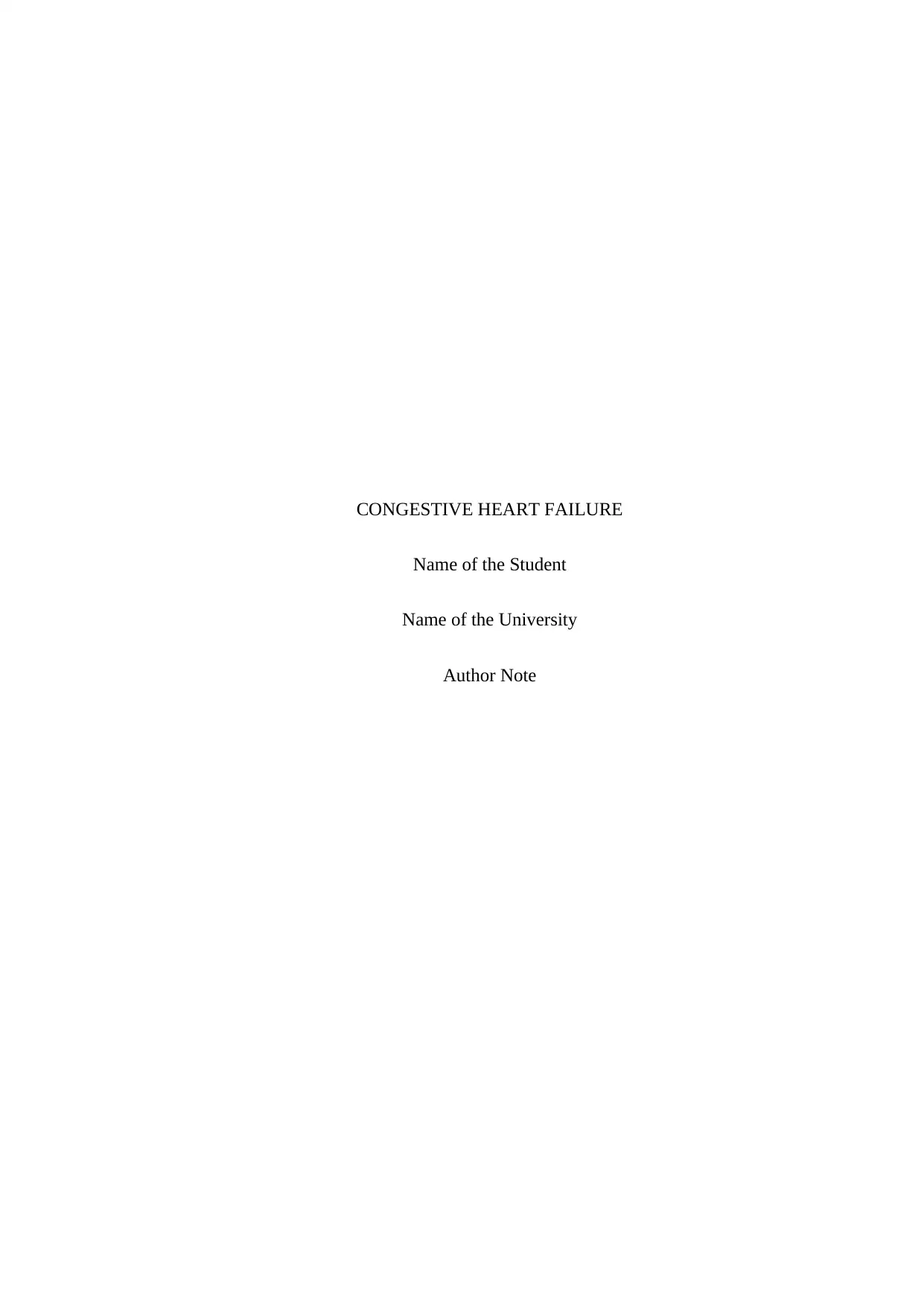
CONGESTIVE HEART FAILURE
Name of the Student
Name of the University
Author Note
Name of the Student
Name of the University
Author Note
Paraphrase This Document
Need a fresh take? Get an instant paraphrase of this document with our AI Paraphraser
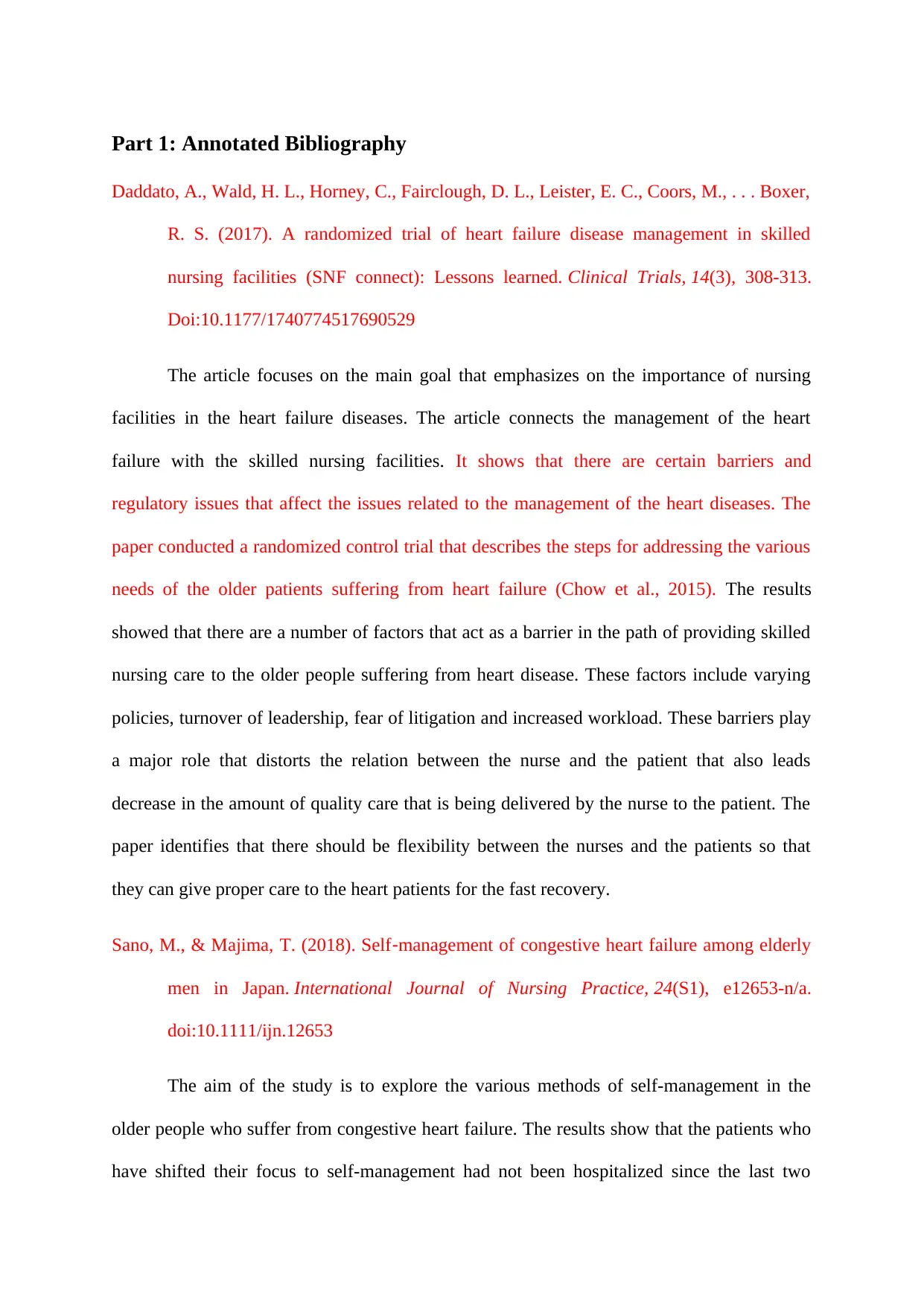
Part 1: Annotated Bibliography
Daddato, A., Wald, H. L., Horney, C., Fairclough, D. L., Leister, E. C., Coors, M., . . . Boxer,
R. S. (2017). A randomized trial of heart failure disease management in skilled
nursing facilities (SNF connect): Lessons learned. Clinical Trials, 14(3), 308-313.
Doi:10.1177/1740774517690529
The article focuses on the main goal that emphasizes on the importance of nursing
facilities in the heart failure diseases. The article connects the management of the heart
failure with the skilled nursing facilities. It shows that there are certain barriers and
regulatory issues that affect the issues related to the management of the heart diseases. The
paper conducted a randomized control trial that describes the steps for addressing the various
needs of the older patients suffering from heart failure (Chow et al., 2015). The results
showed that there are a number of factors that act as a barrier in the path of providing skilled
nursing care to the older people suffering from heart disease. These factors include varying
policies, turnover of leadership, fear of litigation and increased workload. These barriers play
a major role that distorts the relation between the nurse and the patient that also leads
decrease in the amount of quality care that is being delivered by the nurse to the patient. The
paper identifies that there should be flexibility between the nurses and the patients so that
they can give proper care to the heart patients for the fast recovery.
Sano, M., & Majima, T. (2018). Self‐management of congestive heart failure among elderly
men in Japan. International Journal of Nursing Practice, 24(S1), e12653-n/a.
doi:10.1111/ijn.12653
The aim of the study is to explore the various methods of self-management in the
older people who suffer from congestive heart failure. The results show that the patients who
have shifted their focus to self-management had not been hospitalized since the last two
Daddato, A., Wald, H. L., Horney, C., Fairclough, D. L., Leister, E. C., Coors, M., . . . Boxer,
R. S. (2017). A randomized trial of heart failure disease management in skilled
nursing facilities (SNF connect): Lessons learned. Clinical Trials, 14(3), 308-313.
Doi:10.1177/1740774517690529
The article focuses on the main goal that emphasizes on the importance of nursing
facilities in the heart failure diseases. The article connects the management of the heart
failure with the skilled nursing facilities. It shows that there are certain barriers and
regulatory issues that affect the issues related to the management of the heart diseases. The
paper conducted a randomized control trial that describes the steps for addressing the various
needs of the older patients suffering from heart failure (Chow et al., 2015). The results
showed that there are a number of factors that act as a barrier in the path of providing skilled
nursing care to the older people suffering from heart disease. These factors include varying
policies, turnover of leadership, fear of litigation and increased workload. These barriers play
a major role that distorts the relation between the nurse and the patient that also leads
decrease in the amount of quality care that is being delivered by the nurse to the patient. The
paper identifies that there should be flexibility between the nurses and the patients so that
they can give proper care to the heart patients for the fast recovery.
Sano, M., & Majima, T. (2018). Self‐management of congestive heart failure among elderly
men in Japan. International Journal of Nursing Practice, 24(S1), e12653-n/a.
doi:10.1111/ijn.12653
The aim of the study is to explore the various methods of self-management in the
older people who suffer from congestive heart failure. The results show that the patients who
have shifted their focus to self-management had not been hospitalized since the last two
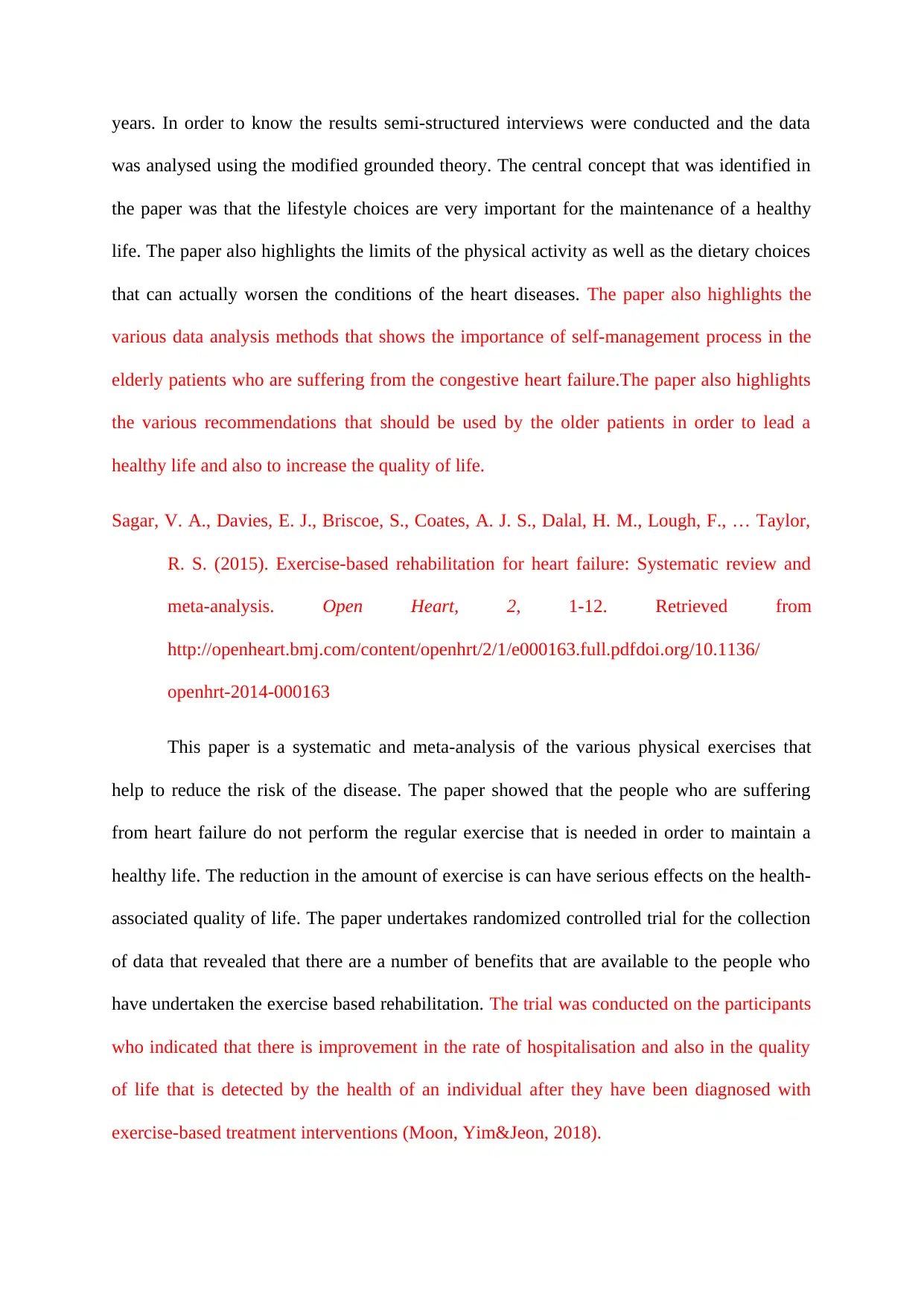
years. In order to know the results semi-structured interviews were conducted and the data
was analysed using the modified grounded theory. The central concept that was identified in
the paper was that the lifestyle choices are very important for the maintenance of a healthy
life. The paper also highlights the limits of the physical activity as well as the dietary choices
that can actually worsen the conditions of the heart diseases. The paper also highlights the
various data analysis methods that shows the importance of self-management process in the
elderly patients who are suffering from the congestive heart failure.The paper also highlights
the various recommendations that should be used by the older patients in order to lead a
healthy life and also to increase the quality of life.
Sagar, V. A., Davies, E. J., Briscoe, S., Coates, A. J. S., Dalal, H. M., Lough, F., … Taylor,
R. S. (2015). Exercise-based rehabilitation for heart failure: Systematic review and
meta-analysis. Open Heart, 2, 1-12. Retrieved from
http://openheart.bmj.com/content/openhrt/2/1/e000163.full.pdfdoi.org/10.1136/
openhrt-2014-000163
This paper is a systematic and meta-analysis of the various physical exercises that
help to reduce the risk of the disease. The paper showed that the people who are suffering
from heart failure do not perform the regular exercise that is needed in order to maintain a
healthy life. The reduction in the amount of exercise is can have serious effects on the health-
associated quality of life. The paper undertakes randomized controlled trial for the collection
of data that revealed that there are a number of benefits that are available to the people who
have undertaken the exercise based rehabilitation. The trial was conducted on the participants
who indicated that there is improvement in the rate of hospitalisation and also in the quality
of life that is detected by the health of an individual after they have been diagnosed with
exercise-based treatment interventions (Moon, Yim&Jeon, 2018).
was analysed using the modified grounded theory. The central concept that was identified in
the paper was that the lifestyle choices are very important for the maintenance of a healthy
life. The paper also highlights the limits of the physical activity as well as the dietary choices
that can actually worsen the conditions of the heart diseases. The paper also highlights the
various data analysis methods that shows the importance of self-management process in the
elderly patients who are suffering from the congestive heart failure.The paper also highlights
the various recommendations that should be used by the older patients in order to lead a
healthy life and also to increase the quality of life.
Sagar, V. A., Davies, E. J., Briscoe, S., Coates, A. J. S., Dalal, H. M., Lough, F., … Taylor,
R. S. (2015). Exercise-based rehabilitation for heart failure: Systematic review and
meta-analysis. Open Heart, 2, 1-12. Retrieved from
http://openheart.bmj.com/content/openhrt/2/1/e000163.full.pdfdoi.org/10.1136/
openhrt-2014-000163
This paper is a systematic and meta-analysis of the various physical exercises that
help to reduce the risk of the disease. The paper showed that the people who are suffering
from heart failure do not perform the regular exercise that is needed in order to maintain a
healthy life. The reduction in the amount of exercise is can have serious effects on the health-
associated quality of life. The paper undertakes randomized controlled trial for the collection
of data that revealed that there are a number of benefits that are available to the people who
have undertaken the exercise based rehabilitation. The trial was conducted on the participants
who indicated that there is improvement in the rate of hospitalisation and also in the quality
of life that is detected by the health of an individual after they have been diagnosed with
exercise-based treatment interventions (Moon, Yim&Jeon, 2018).
⊘ This is a preview!⊘
Do you want full access?
Subscribe today to unlock all pages.

Trusted by 1+ million students worldwide
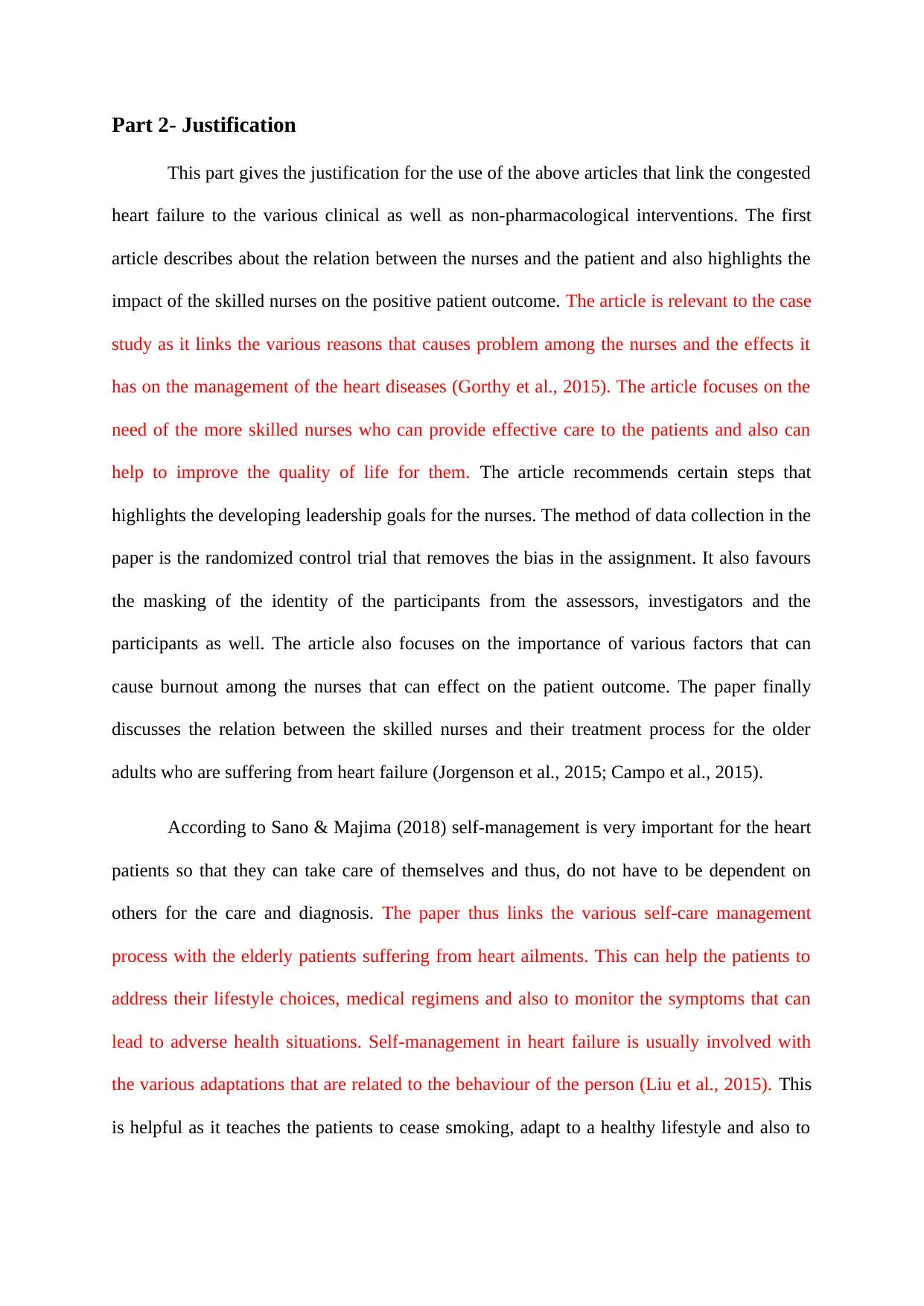
Part 2- Justification
This part gives the justification for the use of the above articles that link the congested
heart failure to the various clinical as well as non-pharmacological interventions. The first
article describes about the relation between the nurses and the patient and also highlights the
impact of the skilled nurses on the positive patient outcome. The article is relevant to the case
study as it links the various reasons that causes problem among the nurses and the effects it
has on the management of the heart diseases (Gorthy et al., 2015). The article focuses on the
need of the more skilled nurses who can provide effective care to the patients and also can
help to improve the quality of life for them. The article recommends certain steps that
highlights the developing leadership goals for the nurses. The method of data collection in the
paper is the randomized control trial that removes the bias in the assignment. It also favours
the masking of the identity of the participants from the assessors, investigators and the
participants as well. The article also focuses on the importance of various factors that can
cause burnout among the nurses that can effect on the patient outcome. The paper finally
discusses the relation between the skilled nurses and their treatment process for the older
adults who are suffering from heart failure (Jorgenson et al., 2015; Campo et al., 2015).
According to Sano & Majima (2018) self-management is very important for the heart
patients so that they can take care of themselves and thus, do not have to be dependent on
others for the care and diagnosis. The paper thus links the various self-care management
process with the elderly patients suffering from heart ailments. This can help the patients to
address their lifestyle choices, medical regimens and also to monitor the symptoms that can
lead to adverse health situations. Self-management in heart failure is usually involved with
the various adaptations that are related to the behaviour of the person (Liu et al., 2015). This
is helpful as it teaches the patients to cease smoking, adapt to a healthy lifestyle and also to
This part gives the justification for the use of the above articles that link the congested
heart failure to the various clinical as well as non-pharmacological interventions. The first
article describes about the relation between the nurses and the patient and also highlights the
impact of the skilled nurses on the positive patient outcome. The article is relevant to the case
study as it links the various reasons that causes problem among the nurses and the effects it
has on the management of the heart diseases (Gorthy et al., 2015). The article focuses on the
need of the more skilled nurses who can provide effective care to the patients and also can
help to improve the quality of life for them. The article recommends certain steps that
highlights the developing leadership goals for the nurses. The method of data collection in the
paper is the randomized control trial that removes the bias in the assignment. It also favours
the masking of the identity of the participants from the assessors, investigators and the
participants as well. The article also focuses on the importance of various factors that can
cause burnout among the nurses that can effect on the patient outcome. The paper finally
discusses the relation between the skilled nurses and their treatment process for the older
adults who are suffering from heart failure (Jorgenson et al., 2015; Campo et al., 2015).
According to Sano & Majima (2018) self-management is very important for the heart
patients so that they can take care of themselves and thus, do not have to be dependent on
others for the care and diagnosis. The paper thus links the various self-care management
process with the elderly patients suffering from heart ailments. This can help the patients to
address their lifestyle choices, medical regimens and also to monitor the symptoms that can
lead to adverse health situations. Self-management in heart failure is usually involved with
the various adaptations that are related to the behaviour of the person (Liu et al., 2015). This
is helpful as it teaches the patients to cease smoking, adapt to a healthy lifestyle and also to
Paraphrase This Document
Need a fresh take? Get an instant paraphrase of this document with our AI Paraphraser
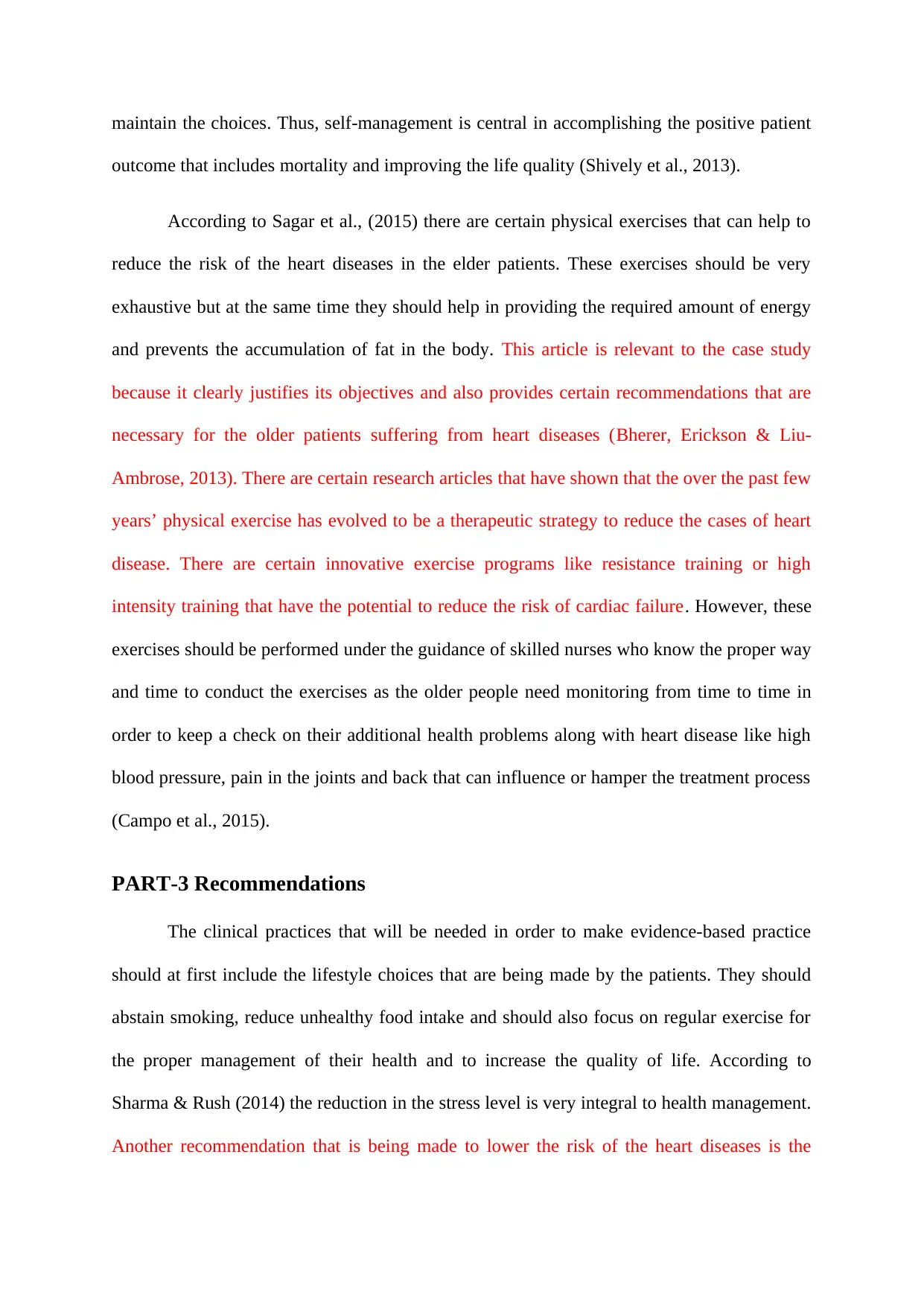
maintain the choices. Thus, self-management is central in accomplishing the positive patient
outcome that includes mortality and improving the life quality (Shively et al., 2013).
According to Sagar et al., (2015) there are certain physical exercises that can help to
reduce the risk of the heart diseases in the elder patients. These exercises should be very
exhaustive but at the same time they should help in providing the required amount of energy
and prevents the accumulation of fat in the body. This article is relevant to the case study
because it clearly justifies its objectives and also provides certain recommendations that are
necessary for the older patients suffering from heart diseases (Bherer, Erickson & Liu-
Ambrose, 2013). There are certain research articles that have shown that the over the past few
years’ physical exercise has evolved to be a therapeutic strategy to reduce the cases of heart
disease. There are certain innovative exercise programs like resistance training or high
intensity training that have the potential to reduce the risk of cardiac failure. However, these
exercises should be performed under the guidance of skilled nurses who know the proper way
and time to conduct the exercises as the older people need monitoring from time to time in
order to keep a check on their additional health problems along with heart disease like high
blood pressure, pain in the joints and back that can influence or hamper the treatment process
(Campo et al., 2015).
PART-3 Recommendations
The clinical practices that will be needed in order to make evidence-based practice
should at first include the lifestyle choices that are being made by the patients. They should
abstain smoking, reduce unhealthy food intake and should also focus on regular exercise for
the proper management of their health and to increase the quality of life. According to
Sharma & Rush (2014) the reduction in the stress level is very integral to health management.
Another recommendation that is being made to lower the risk of the heart diseases is the
outcome that includes mortality and improving the life quality (Shively et al., 2013).
According to Sagar et al., (2015) there are certain physical exercises that can help to
reduce the risk of the heart diseases in the elder patients. These exercises should be very
exhaustive but at the same time they should help in providing the required amount of energy
and prevents the accumulation of fat in the body. This article is relevant to the case study
because it clearly justifies its objectives and also provides certain recommendations that are
necessary for the older patients suffering from heart diseases (Bherer, Erickson & Liu-
Ambrose, 2013). There are certain research articles that have shown that the over the past few
years’ physical exercise has evolved to be a therapeutic strategy to reduce the cases of heart
disease. There are certain innovative exercise programs like resistance training or high
intensity training that have the potential to reduce the risk of cardiac failure. However, these
exercises should be performed under the guidance of skilled nurses who know the proper way
and time to conduct the exercises as the older people need monitoring from time to time in
order to keep a check on their additional health problems along with heart disease like high
blood pressure, pain in the joints and back that can influence or hamper the treatment process
(Campo et al., 2015).
PART-3 Recommendations
The clinical practices that will be needed in order to make evidence-based practice
should at first include the lifestyle choices that are being made by the patients. They should
abstain smoking, reduce unhealthy food intake and should also focus on regular exercise for
the proper management of their health and to increase the quality of life. According to
Sharma & Rush (2014) the reduction in the stress level is very integral to health management.
Another recommendation that is being made to lower the risk of the heart diseases is the
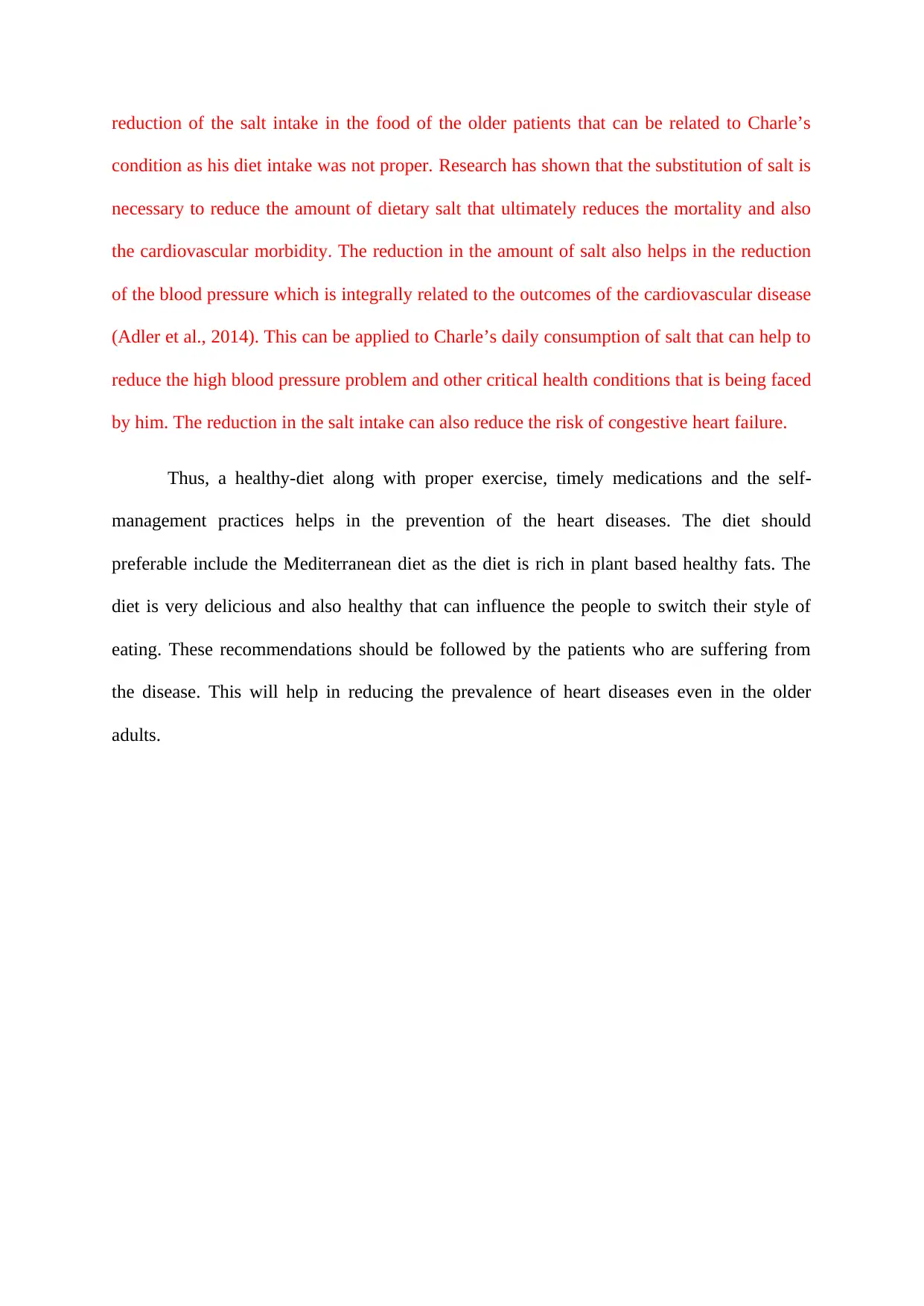
reduction of the salt intake in the food of the older patients that can be related to Charle’s
condition as his diet intake was not proper. Research has shown that the substitution of salt is
necessary to reduce the amount of dietary salt that ultimately reduces the mortality and also
the cardiovascular morbidity. The reduction in the amount of salt also helps in the reduction
of the blood pressure which is integrally related to the outcomes of the cardiovascular disease
(Adler et al., 2014). This can be applied to Charle’s daily consumption of salt that can help to
reduce the high blood pressure problem and other critical health conditions that is being faced
by him. The reduction in the salt intake can also reduce the risk of congestive heart failure.
Thus, a healthy-diet along with proper exercise, timely medications and the self-
management practices helps in the prevention of the heart diseases. The diet should
preferable include the Mediterranean diet as the diet is rich in plant based healthy fats. The
diet is very delicious and also healthy that can influence the people to switch their style of
eating. These recommendations should be followed by the patients who are suffering from
the disease. This will help in reducing the prevalence of heart diseases even in the older
adults.
condition as his diet intake was not proper. Research has shown that the substitution of salt is
necessary to reduce the amount of dietary salt that ultimately reduces the mortality and also
the cardiovascular morbidity. The reduction in the amount of salt also helps in the reduction
of the blood pressure which is integrally related to the outcomes of the cardiovascular disease
(Adler et al., 2014). This can be applied to Charle’s daily consumption of salt that can help to
reduce the high blood pressure problem and other critical health conditions that is being faced
by him. The reduction in the salt intake can also reduce the risk of congestive heart failure.
Thus, a healthy-diet along with proper exercise, timely medications and the self-
management practices helps in the prevention of the heart diseases. The diet should
preferable include the Mediterranean diet as the diet is rich in plant based healthy fats. The
diet is very delicious and also healthy that can influence the people to switch their style of
eating. These recommendations should be followed by the patients who are suffering from
the disease. This will help in reducing the prevalence of heart diseases even in the older
adults.
⊘ This is a preview!⊘
Do you want full access?
Subscribe today to unlock all pages.

Trusted by 1+ million students worldwide

Paraphrase This Document
Need a fresh take? Get an instant paraphrase of this document with our AI Paraphraser
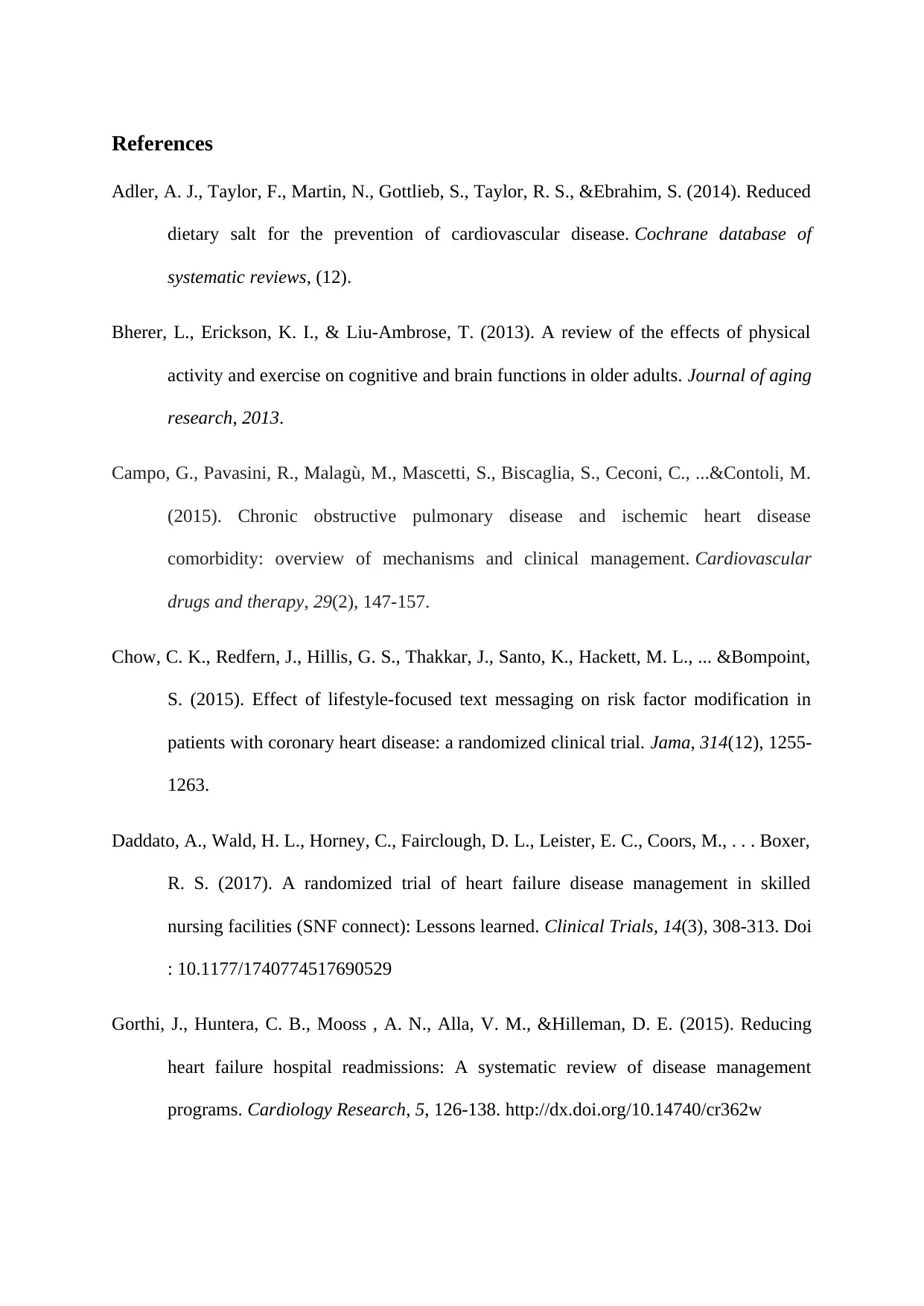
References
Adler, A. J., Taylor, F., Martin, N., Gottlieb, S., Taylor, R. S., &Ebrahim, S. (2014). Reduced
dietary salt for the prevention of cardiovascular disease. Cochrane database of
systematic reviews, (12).
Bherer, L., Erickson, K. I., & Liu-Ambrose, T. (2013). A review of the effects of physical
activity and exercise on cognitive and brain functions in older adults. Journal of aging
research, 2013.
Campo, G., Pavasini, R., Malagù, M., Mascetti, S., Biscaglia, S., Ceconi, C., ...&Contoli, M.
(2015). Chronic obstructive pulmonary disease and ischemic heart disease
comorbidity: overview of mechanisms and clinical management. Cardiovascular
drugs and therapy, 29(2), 147-157.
Chow, C. K., Redfern, J., Hillis, G. S., Thakkar, J., Santo, K., Hackett, M. L., ... &Bompoint,
S. (2015). Effect of lifestyle-focused text messaging on risk factor modification in
patients with coronary heart disease: a randomized clinical trial. Jama, 314(12), 1255-
1263.
Daddato, A., Wald, H. L., Horney, C., Fairclough, D. L., Leister, E. C., Coors, M., . . . Boxer,
R. S. (2017). A randomized trial of heart failure disease management in skilled
nursing facilities (SNF connect): Lessons learned. Clinical Trials, 14(3), 308-313. Doi
: 10.1177/1740774517690529
Gorthi, J., Huntera, C. B., Mooss , A. N., Alla, V. M., &Hilleman, D. E. (2015). Reducing
heart failure hospital readmissions: A systematic review of disease management
programs. Cardiology Research, 5, 126-138. http://dx.doi.org/10.14740/cr362w
Adler, A. J., Taylor, F., Martin, N., Gottlieb, S., Taylor, R. S., &Ebrahim, S. (2014). Reduced
dietary salt for the prevention of cardiovascular disease. Cochrane database of
systematic reviews, (12).
Bherer, L., Erickson, K. I., & Liu-Ambrose, T. (2013). A review of the effects of physical
activity and exercise on cognitive and brain functions in older adults. Journal of aging
research, 2013.
Campo, G., Pavasini, R., Malagù, M., Mascetti, S., Biscaglia, S., Ceconi, C., ...&Contoli, M.
(2015). Chronic obstructive pulmonary disease and ischemic heart disease
comorbidity: overview of mechanisms and clinical management. Cardiovascular
drugs and therapy, 29(2), 147-157.
Chow, C. K., Redfern, J., Hillis, G. S., Thakkar, J., Santo, K., Hackett, M. L., ... &Bompoint,
S. (2015). Effect of lifestyle-focused text messaging on risk factor modification in
patients with coronary heart disease: a randomized clinical trial. Jama, 314(12), 1255-
1263.
Daddato, A., Wald, H. L., Horney, C., Fairclough, D. L., Leister, E. C., Coors, M., . . . Boxer,
R. S. (2017). A randomized trial of heart failure disease management in skilled
nursing facilities (SNF connect): Lessons learned. Clinical Trials, 14(3), 308-313. Doi
: 10.1177/1740774517690529
Gorthi, J., Huntera, C. B., Mooss , A. N., Alla, V. M., &Hilleman, D. E. (2015). Reducing
heart failure hospital readmissions: A systematic review of disease management
programs. Cardiology Research, 5, 126-138. http://dx.doi.org/10.14740/cr362w
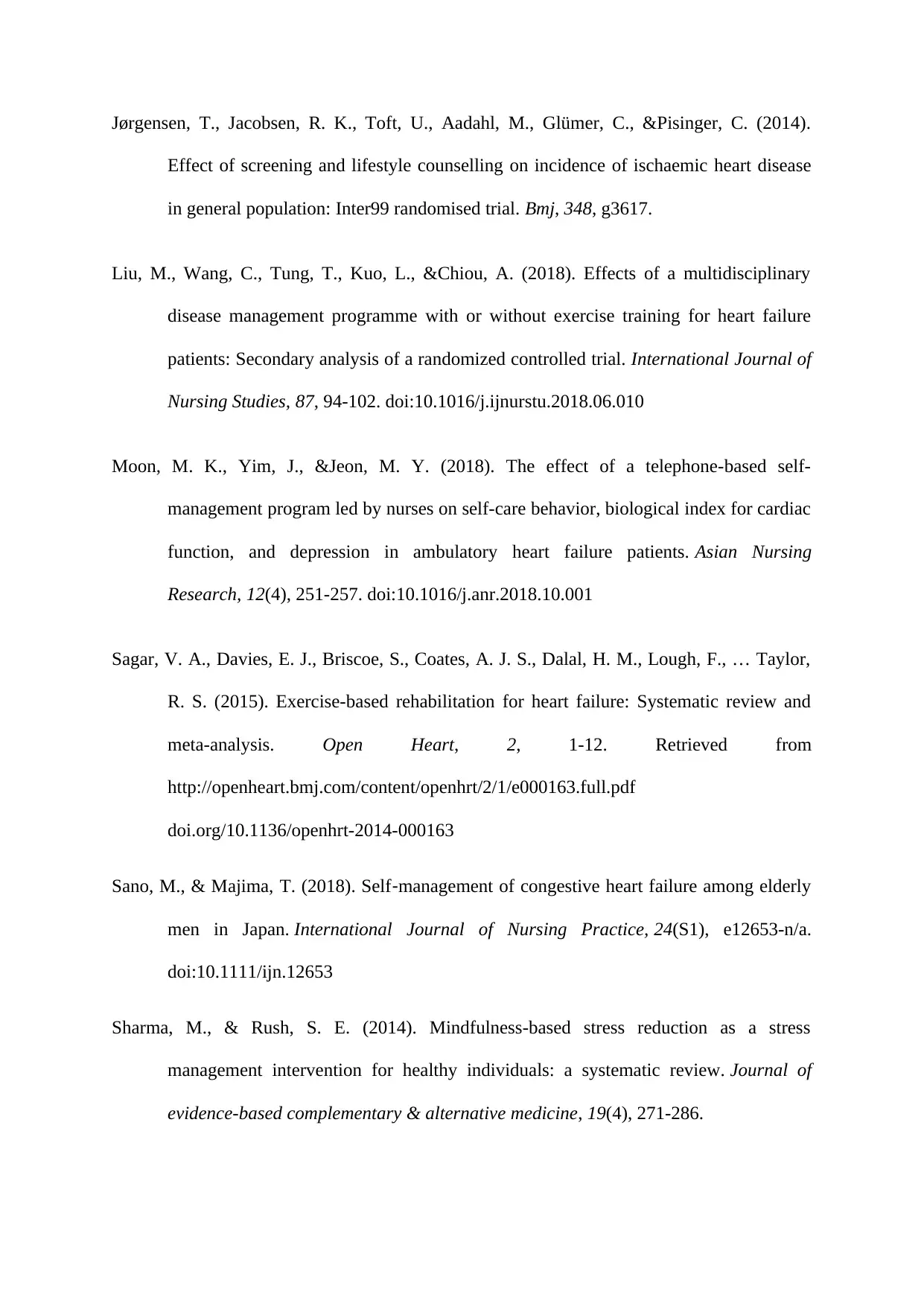
Jørgensen, T., Jacobsen, R. K., Toft, U., Aadahl, M., Glümer, C., &Pisinger, C. (2014).
Effect of screening and lifestyle counselling on incidence of ischaemic heart disease
in general population: Inter99 randomised trial. Bmj, 348, g3617.
Liu, M., Wang, C., Tung, T., Kuo, L., &Chiou, A. (2018). Effects of a multidisciplinary
disease management programme with or without exercise training for heart failure
patients: Secondary analysis of a randomized controlled trial. International Journal of
Nursing Studies, 87, 94-102. doi:10.1016/j.ijnurstu.2018.06.010
Moon, M. K., Yim, J., &Jeon, M. Y. (2018). The effect of a telephone-based self-
management program led by nurses on self-care behavior, biological index for cardiac
function, and depression in ambulatory heart failure patients. Asian Nursing
Research, 12(4), 251-257. doi:10.1016/j.anr.2018.10.001
Sagar, V. A., Davies, E. J., Briscoe, S., Coates, A. J. S., Dalal, H. M., Lough, F., … Taylor,
R. S. (2015). Exercise-based rehabilitation for heart failure: Systematic review and
meta-analysis. Open Heart, 2, 1-12. Retrieved from
http://openheart.bmj.com/content/openhrt/2/1/e000163.full.pdf
doi.org/10.1136/openhrt-2014-000163
Sano, M., & Majima, T. (2018). Self‐management of congestive heart failure among elderly
men in Japan. International Journal of Nursing Practice, 24(S1), e12653-n/a.
doi:10.1111/ijn.12653
Sharma, M., & Rush, S. E. (2014). Mindfulness-based stress reduction as a stress
management intervention for healthy individuals: a systematic review. Journal of
evidence-based complementary & alternative medicine, 19(4), 271-286.
Effect of screening and lifestyle counselling on incidence of ischaemic heart disease
in general population: Inter99 randomised trial. Bmj, 348, g3617.
Liu, M., Wang, C., Tung, T., Kuo, L., &Chiou, A. (2018). Effects of a multidisciplinary
disease management programme with or without exercise training for heart failure
patients: Secondary analysis of a randomized controlled trial. International Journal of
Nursing Studies, 87, 94-102. doi:10.1016/j.ijnurstu.2018.06.010
Moon, M. K., Yim, J., &Jeon, M. Y. (2018). The effect of a telephone-based self-
management program led by nurses on self-care behavior, biological index for cardiac
function, and depression in ambulatory heart failure patients. Asian Nursing
Research, 12(4), 251-257. doi:10.1016/j.anr.2018.10.001
Sagar, V. A., Davies, E. J., Briscoe, S., Coates, A. J. S., Dalal, H. M., Lough, F., … Taylor,
R. S. (2015). Exercise-based rehabilitation for heart failure: Systematic review and
meta-analysis. Open Heart, 2, 1-12. Retrieved from
http://openheart.bmj.com/content/openhrt/2/1/e000163.full.pdf
doi.org/10.1136/openhrt-2014-000163
Sano, M., & Majima, T. (2018). Self‐management of congestive heart failure among elderly
men in Japan. International Journal of Nursing Practice, 24(S1), e12653-n/a.
doi:10.1111/ijn.12653
Sharma, M., & Rush, S. E. (2014). Mindfulness-based stress reduction as a stress
management intervention for healthy individuals: a systematic review. Journal of
evidence-based complementary & alternative medicine, 19(4), 271-286.
⊘ This is a preview!⊘
Do you want full access?
Subscribe today to unlock all pages.

Trusted by 1+ million students worldwide
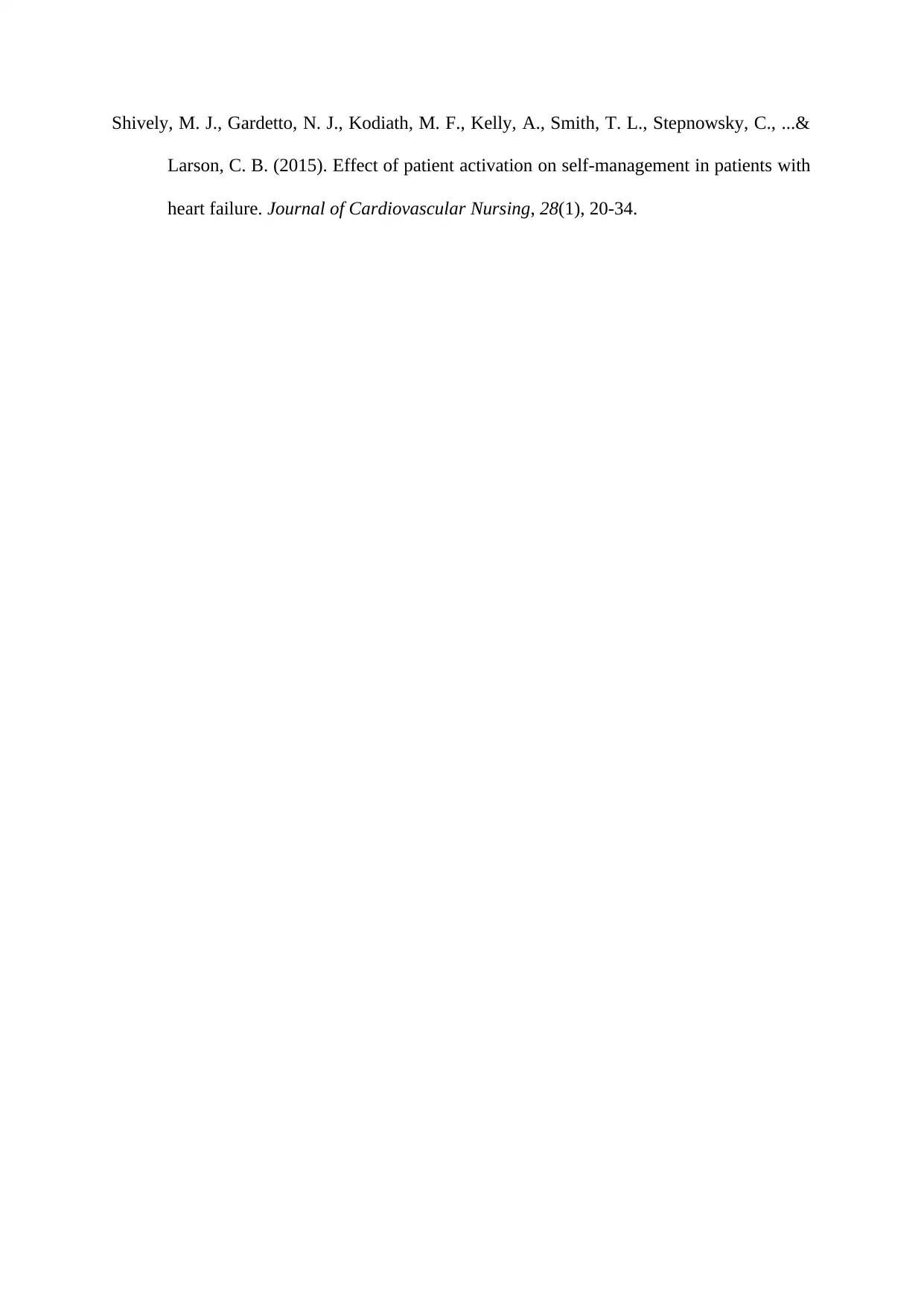
Shively, M. J., Gardetto, N. J., Kodiath, M. F., Kelly, A., Smith, T. L., Stepnowsky, C., ...&
Larson, C. B. (2015). Effect of patient activation on self-management in patients with
heart failure. Journal of Cardiovascular Nursing, 28(1), 20-34.
Larson, C. B. (2015). Effect of patient activation on self-management in patients with
heart failure. Journal of Cardiovascular Nursing, 28(1), 20-34.
1 out of 10
Related Documents
Your All-in-One AI-Powered Toolkit for Academic Success.
+13062052269
info@desklib.com
Available 24*7 on WhatsApp / Email
![[object Object]](/_next/static/media/star-bottom.7253800d.svg)
Unlock your academic potential
Copyright © 2020–2025 A2Z Services. All Rights Reserved. Developed and managed by ZUCOL.





